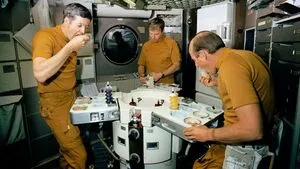Adverts
Space exploration has always captivated the human imagination, and a fundamental aspect of this journey is the nutrition of astronauts. Food in space is not only a nutritional necessity, but also a logistical and technological challenge.
In this article, we'll delve into the fascinating world of space food, exploring everything from the earliest missions to the most recent innovations. We'll discover how astronauts thrive in the unique environment of space, the challenges they face and the creative solutions they develop.
Adverts
From the first manned flights to the longest missions on the International Space Station, food in space has evolved significantly, driven by the need to provide astronauts with not only adequate nutrition but also comfort and variety.
Let's explore this extraterrestrial gastronomic universe and discover the secrets behind meals in space.
Adverts
Nutritional Needs in Space
Astronauts' nutritional needs are complex due to the unique environment of space, where lack of gravity can affect the digestive system and nutrient absorption. Therefore, foods must be carefully selected and prepared to ensure they meet the specific demands of the human body in space.
Energy is essential to maintain vital functions and perform physical activities, while proteins are necessary to repair damaged muscle and bone tissues. Vitamins and minerals play crucial roles in immune system function and preventing nutritional deficiencies.
Adverts
Additionally, food in space needs to be light and compact to save space and weight on spacecraft, allowing for more useful supplies and equipment. The long shelf life of food is crucial, ensuring that astronauts have access to safe, nutritious food throughout missions that can last weeks or even months.
The Packaging and Storage Challenge
Food packaging and storage are crucial challenges for space missions, as every gram of payload transported into space has a significant impact on spacecraft costs and capacity.
Adverts
Space agencies have developed advanced packaging techniques, such as vacuum packaging and airtight packaging, which reduce volume and prevent food contamination. Furthermore, food must be protected against cosmic radiation and temperature fluctuations in space, which can compromise its quality and safety.
Therefore, storage containers must be designed to ensure food stability and integrity throughout the entire mission, from launch to return to Earth.
This attention to detail in packaging and storage is essential to ensuring astronauts have access to safe, nutritious food during their stay in space.
Menu Options for Astronauts
In addition to conventional meals, astronauts also enjoy a variety of snacks and treats specially designed for consumption in space. Cereal bars, freeze-dried fruits, chocolate and even ice cream are some of the options available for moments of relaxation during long missions.
However, it is important to note that even with this diversity of options, astronauts' dietary restrictions and individual needs are carefully considered.
For example, some crew members may require special diets due to food allergies or specific health conditions, while others may have cultural preferences that influence their food choices.
Therefore, space agencies work closely with nutritionists and health experts to ensure that each astronaut receives a diet adapted to their needs and preferences, thus contributing to the well-being and success of space missions.
Innovations in Space Food
With the advancement of technology, new techniques and technologies are being developed to improve food in space.
3D food printing, for example, offers the possibility of creating personalized meals adapted to the specific needs of each astronaut, in addition to providing a variety of textures and flavors.
Growing plants in space is another promising area of research, not only as a source of fresh food, but also for its contribution to regulating the spacecraft environment, through air recycling and oxygen production.
Furthermore, creating tastier and more nutritious food is a priority, seeking to make eating in space not only functional, but also pleasurable.
These innovations not only improve astronauts' dining experience, but also contribute to the sustainability and autonomy of long-duration space missions.
Psychological Impact on Astronauts
Plus, food in space often serves as a comforting reminder of home and life on Earth. Astronauts' favorite foods, like pizza or chocolate, can bring a sense of normalcy and comfort amid the alien environment of space.
Food also plays a crucial role in celebrations and special events aboard the space station, helping astronauts maintain a sense of community and camaraderie.

However, despite the importance of food for the psychological well-being of astronauts, it is also necessary to balance gastronomic pleasure with nutritional demands and operational constraints.
The challenge is finding the sweet spot where food in space is not only nutritious and safe, but also enjoyable and comforting for astronauts, thus ensuring they can face the challenges of space exploration in physical and mental health.
Conclusion
Food in space is not just a matter of nutrition, but also plays a crucial role in the physical and mental health of astronauts.
A balanced and satisfying diet is essential to ensure that crew members maintain good health, physical resistance and psychological well-being during long and challenging journeys in space.
Additionally, food can also serve as an emotional connection to Earth, bringing comfort and memories of home to astronauts who are far from their loved ones and familiar surroundings.
Therefore, investing in research and development of space food technologies is a priority for space agencies, aiming to not only meet nutritional needs but also provide a rewarding and meaningful gastronomic experience for space explorers.
With the continued advancement of technology and food science, we can be certain that the future of food in space will be even more exciting and promising, paving the way for a new era of sustainable and inspiring space exploration.
